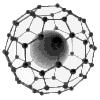DMT-Nexus member
Posts: 29 Joined: 17-Jan-2013 Last visit: 22-May-2020
|
Not sure if this the best of places to put this but I feel the need to share some info and hopefully move forward with things for myself and with any luck help someone else out.
I have been very interested in playing with tetrahydroharmine, the effects are interesting and I very much enjoy doing the reading on how the chemistry works. I tried the vinegar and zinc method and that was fun and all but I didn't like added steps to remove the zinc. I had read that adding excessive naoh might let the zinc precipitate become water soluble but when I tried that with just zinc water and a chunk of naoh I still had the precipitate. Reading into things, its stated that aluminum will eventually redissolve back into water and might even be a better metal to use anyway. So I picked up some fine aluminum powder for a few bucks and test it out. I will throw this out there, aluminum and HCl react more violently than anything I had with the zinc, if anyone wants to try this do it with adequate caution. Anyway, after letting the aluminum dissolve and cool down I slowly added naoh and shook the container. It didn't take long and the liquid gelled up, I then added a chunk more naoh and shook and to my surprise it looked like I just had water. This was all good news so I took my relatively clean harmala alkaloids and did some half asked separation to make sure the bulk of what I had was harmine. I threw it in a glass container with a generous amount of HCl and slowly added maybe 5g of aluminum powder. I shook it pretty well on and off over a 24 hour period, and could still see it bubbling. I then filtered out the remaining aluminum powder and took a small portion of liquid to play with. I added an excessive amount of naoh and removed what ended up settling at the bottom and redissolved it in a new container with HCl. I compared what I had with a UV light. Whatever becomes of the aluminum has a light turquoise glow and what I had hoped was harmala alkaloids had was a nice shade of blue. I have since added excessive amounts of naoh to the rest of this test batch and as expected it went to a tell and back, but this time I was a little worried that maybe I was too impatient and got it too hot and destroyed the alkaloids as Iddidn't see anything precipitate out after the grll cycle. Well now its a day later and I have a fair chunk of something floating around. I'm going to separate and repeat the acid/base cycle a time or two and wash it out to remove the naoh and see what happens. I hope by then the aluminum is gone and I actually have thh in the end.
Sorry for one large paragraph, I am on my tablet and can't see much as I type and just rambled on for a while.
|
|
|
|
|

DMT-Nexus member
Posts: 503 Joined: 11-May-2013 Last visit: 29-Nov-2020
|
Save the stuff that is blue under UV, that's the THH. The stuff that precipitates when you first add the NaOH is the THH.
|
|
|
DMT-Nexus member
Posts: 29 Joined: 17-Jan-2013 Last visit: 22-May-2020
|
Yep yep that is the idea, however I shouldn't get too excited about color as the aluminum buts that end up dissolved in water could be seen as glowing blue as well. Right now I'm waiting on things to settle again so I can pour out and replace a bulk of the water, I think I'm going to do this until there is no more glow from the aluminum and the pH gets close to 7. Hopefully both happen at the same time. I'll probably dry out what I get and dissolve it all back into some methanol just to see what gets left behind so I know for sure that the aluminum is gone.
On a related note, how would I go about salting it with HCl and keeping it as a powder without ruining my oven or whatever. If it would be easier I also have what is supposed to be pure citric acid.
|
|
|

DMT-Nexus member
Posts: 503 Joined: 11-May-2013 Last visit: 29-Nov-2020
|
I think there will usually be some residual THH that doesn't precipitate when you add NaOH, so the blue you are seeing left behind may just be small amounts of THH in solution.
I just keep mine as the freebase, washing it with dilute sodium carbonate solution to remove the NaOH.
|
|
|
DMT-Nexus member
Posts: 415 Joined: 29-Aug-2010 Last visit: 06-Feb-2024 Location: philadelphia, pa, usa
|
woah... i would be really cautious about using aluminum... that stuff is really bad for your brain even in small amounts...
magnesium metal is food safe as it simply forms magnesium chloride which most folks are deficient in.
buy the magnesium ribbons online, they are pretty cheap ($4 for 25g) and the ribbons don't have violent reactions like the powder..
|
|
|

Kalt und Heiß, Schwarz und Rot, Kürper und Geist, Liebe und Chaos
 
Posts: 4661 Joined: 02-Jun-2008 Last visit: 30-Apr-2022
|
@OP please make sure that you have separated harmaline from harmine before attempting the reduction. Harmine does not get reduced to THH and it will be present in the final problem, thus confounding any of your THH experiences. Need to calculate between salts and freebases? Click here! Need to calculate freebase or salt percentage at a given pH? Click here!
|
|
|

DMT-Nexus member
Posts: 1263 Joined: 01-Jun-2014 Last visit: 10-Aug-2019
|
moyshekapoyre wrote:woah... i would be really cautious about using aluminum... that stuff is really bad for your brain even in small amounts...
magnesium metal is food safe as it simply forms magnesium chloride which most folks are deficient in.
buy the magnesium ribbons online, they are pretty cheap ($4 for 25g) and the ribbons don't have violent reactions like the powder.. Tell us more...did you do a successfull magnesium reduction?
|
|
|

DMT-Nexus member
Posts: 8 Joined: 14-Nov-2015 Last visit: 25-Mar-2017 Location: Basel
|
Hello anyone, I have a question or two and in the manner of not wanna botter an fresh discussion yet before I made practical experience and because it relates pretty good to this one I ask it here (or would this be better in the older "THH extraction with zinc works!"-thread?):
I was looking for zinc on the web and I have found three types; dust (nanopowder), powder and fripperies (flakes). It is said to be clean and usable in chemical and/or fireworks productions.
So, because I have read a few times about taking aluminum flakes or ribbons and the problem of getting rid of the zinc or aluminum carbonate here are my questions:
- Would it be a good idea to use the zinc fripperies [Zn, 99.2%, D90, <63µm, flaky]?
- If I would, will there also stay reacted zinc carbonate in the result to get rid off?
- If there wouldn't be any zinc carbonate reactions in the solution, can one just filter out the zinc trumpery and have clean THH in the solution? Or otherwise if so, would these 63µm-sized zinc flakes be a good idea anyway to make sure not having more excess zinc carbonate than needed after filter the zinc frippery out?
- If the flitter thing would be a bad idea at all, what would be better then:
1. Zinc powder "325mesh" [Zn, >99,50%, <45micron, spherical (atomized)] or
2. Zinc dust (nano zinc powder) "625mesh" [Zn, >99,60% (Pb <0,013%), <20micron, spherical, consistently (particle size carv-up reaching down to nanoscale, therefrom very reactive)]?
The nanopowder, if usable in a save way, is a bit more expensive, but I guess because of high reactiveness one would use much less of it (I even think of excess would be a bad idea).
This pyropowder shop sells a whole lot of synthetic material & metal powders and also many chemicals. With the beginning of next year I will make up some tests with my new hobby and therefore I will tell my results here in the forum.
Is it allowed to put a link into my post, where the pyropowder shops sortiment is listed so that people can give me hints and advises, witch substances would be worth of tryin' for a conversation/extraction (it is a legal shop in Europe with legal products)? Maybe this way I'll have good results sooner, cheaper and cleaner..?
Thanx
|
|
|

DMT-Nexus member
Posts: 368 Joined: 09-Jun-2011 Last visit: 27-Nov-2020
|
Neat to see someone else interested in the harmaline to THH reduction. The only reductions I have read about use zinc powder. Zinc dust would likely work too, but you need to be able to filter it out of solution after the reduction runs its course. I had no trouble running the reaction with powder. I don't know anything about fripperies, but would avoid it since its purity is lower. If running the reduction using vinegar you will be producing either zinc carbonate (if basifying with sodium carbonate or other carbonate) or zinc hydroxide (if basifying with NaOH). The zinc salt is tricky to separate from the THH. Several potential solutions are out there, primarily washing the precipitate with ethanol to draw off the zinc salts; or basifying with an excess of NaOH, which will make the zinc dissolve back into solution. I haven't read a definitive report of either working. The other route is to run the reduction with HCl, and precipitate with ammonia in the presence of ammonium chloride (available in the U.S. cheaply). You can read about my experiment in this link: Harmaline -> THH by a non-chemist of little brainThat work was preliminary, and if you read the thread, you will see that I need to make some improvements to my technique before I make a 'tek' out of it. The results were promising, however, and I think it is a good starting point for folks to work with.
|
|
|

dysfunctional word machine

Posts: 1831 Joined: 15-Mar-2014 Last visit: 26-Mar-2025 Location: at the center of my universe
|
Zinc chips are not useful for reductions. Zinc powder for pyrotechnics use may be passivated, which could be detrimental when used in reduction reactions.
Most important is to verify that your zinc contains no cadmium, lead or arsenic. These toxic metals are common impurities in zinc ore. Only highly refined zinc does not contain these. You do not want to consume these toxic metals, many are accumulative poisons or even carcinogenic. I am not sure if pyro grade zinc is sufficiently free from these heavy metals. Buyer beware. Try to get an elemental analysis or other sort of certificate of purity.
|
|
|

DMT-Nexus member
Posts: 8 Joined: 14-Nov-2015 Last visit: 25-Mar-2017 Location: Basel
|
Thanks for these statements. So let's get this straight to give some more data and information.
I am pretty sure that the zinc and other metals from this seller are not passivated, but thank you for the hint, I'll check that bevore buying. Also, I'll check for a certificate that there are no toxic addenda.
The seller's homepage's shop states that all metal powders and chemicals from them are high quality products of Germany and are said to be viable for pyrotech-applications AND the chemical use:
- The zinc chips are told to be used in systems of casting resin and for corrosion protection.
- The zinc powder is told to be used for metallurgy, conformal coating, battery fuel, electrode material, thermal sputter (surfacecoating).
- The zinc dust is for metallurgy, conformal coating, battery fuel, electrode material, thermal sputter (surfacecoating) and for use in chemical industry.
The particle's properties I have written in the first post were ratified by ASTM, the "American society for testing and materials" and should be correct.
Sorry for I'm no chemist and so I have to ask these questions in the first place:
As I understood, the conversation from harmaline to THH is done by hydrogen gas built by zinc reacting with acids. Is that true? In the "Harmaline to THH reduction with zinc and vinegar works! (GC-MS results)"-thread, people has mentioned to test little pieces of aluminum foil as conversation agent would be a good idea. Why shouldn't zinc chips therefore? The question I have in the first place here is this: If I take zinc chips, or for example think of a zinc-plate, would there be zinc carbonate / zinc hydroxide produced when basified even when the original zinc material is taken out? I mean, do zinc molecule leave from the plate (or chips) into solution as zinc carbonate/hydroxide? Therefore it should happen, that if one puts a zinc plate into a acid solution there would be a corrosive effect? Is it that what happens?
Thank you for helping me understand this better!
|
|
|

dysfunctional word machine

Posts: 1831 Joined: 15-Mar-2014 Last visit: 26-Mar-2025 Location: at the center of my universe
|
All the uses you mention are indifferent to levels of toxic metal impurities that would otherwise be unacceptable for human consumption. You need not just chemical grade zinc, you need pharmaceutical grade. Read this https://en.wikipedia.org/wiki/Zi...ometallurgical_processes and particularly this: https://en.wikipedia.org/wiki/Zinc_refining. I'm not sure about the mechanism of the reduction. If anyone can point us to a description or a named reaction, that would be a nice starting point for further studies. What you propose is called nascent hydrogen, it is no longer thought to be a true mechanism. EDIT: Any hydrogen forming is in fact a side reaction. We want to reduce the harmaline to tetrahydroharmine, not to reduce the acidic protons to molecular hydrogen.
|
|
|

DMT-Nexus member
Posts: 557 Joined: 12-Jul-2012 Last visit: 01-Jan-2021
|
sesamstrasse1312 wrote:...if one puts a zinc plate into a acid solution there would be a corrosive effect? Is it that what happens? Yup. When one thing is reduced something else is oxidized. Reducing harmaline to THH oxidizes the zinc, chemically speaking. It makes the zinc go from the metal to a salt form. Zinc acetate if you use vinegar, zinc hydrochloride if you use hydrochloric acid, either way some zinc ends up in solution and thats what can base out along with the alkaloid.
|
|
|

DMT-Nexus member
Posts: 8 Joined: 14-Nov-2015 Last visit: 25-Mar-2017 Location: Basel
|
Ok, thanks a lot! So as I understand: In any case there will be zinc end up in some form and in solution and therefore it's useless to filter out excess zinc for example chips. Therefore I have to take the most pure form of zinc. So what I could find so far by a search through the web, is... 1. Zinc dust (nano zinc powder) "625mesh" [Zn, >99,60% (Pb <0,013%), <20micron, spherical, consistently (particle size carv-up reaching down to nanoscale, therefrom very reactive)] from pyropowders.de for chemical use. and 2. pure zinc-oxid minerally powder witch is available in pharmacies for example dental or dermatological use. Would it be stupid to give that 99.6% nanoscale carv-up zinc dust a chance? Would it then be possible to test the end-product ofor purity so that there is nothing left in my THH? Or would pure zinc oxide rather do it? Maybe anyone has an Idea where to buy pure zinc for pharmaceutical use or can tell where people bought it that have already made some experiments with that? I'm glad that I can evaluate these questions in the welcome discussion so that I'm prepared for my experimentation start up. Thanks to the Nexus for that and thanks to all researchers that already have made information available in certain threads.  Another question I have is, if it is necessary to put excess zinc into the conversation processs or would it be possible to do it slow by slow with rather just as much is needed. And how much is needed for a minimum reaction that is usable?
|
|
|

DMT-Nexus member
Posts: 4031 Joined: 28-Jun-2012 Last visit: 05-Mar-2024
|
No zink oxide! As pointed out in the existing THH threads  
|
|
|

DMT-Nexus member
Posts: 8 Joined: 14-Nov-2015 Last visit: 25-Mar-2017 Location: Basel
|
|
|
|

dysfunctional word machine

Posts: 1831 Joined: 15-Mar-2014 Last visit: 26-Mar-2025 Location: at the center of my universe
|
sesamstrasse1312 wrote:Yeah, have read all the nexus THH conversation, pKa and TLC threads, but missed to memorize'em all heartly  Memorizing only will increase your confusion, instead of your knowledge. Try to understand what is written. Research what you don't understand yet. In this case, zinc oxide is useless, because it is already oxidized. You want to use the zinc as a reducing agent. That means that the reducing agent will be oxidized in the reaction. Zinc oxide will not be further oxidized, so it is useless as a reducing agent. sesamstrasse1312 wrote: Thanks for staying with me guys. I'll ask a chemist friend, if he does not know a better source I'll bet on the 99.6% and give it a try with a small amount, slow by slow.  99.6% zinc will be adequate for the reaction. Just beware of potential toxic heavy metal content when making thh for consumption use. If you are only trying to research the fluorescent properties of thh, then there is no problem with that.
|
|
|

DMT-Nexus member
Posts: 8 Joined: 14-Nov-2015 Last visit: 25-Mar-2017 Location: Basel
|
pitubo wrote:Memorizing only will increase your confusion, instead of your knowledge. Try to understand what is written. Research what you don't understand yet. Yes, that's exactly what I got used to.  pitubo wrote:In this case, zinc oxide is useless, because it is already oxidized. (...) Zinc oxide will not be further oxidized, so it is useless as a reducing Agent. Holding in mind above understanding and by thinking for myself (and regaining trust to that ability) I realized that oxid cannot oxidize so far.  pitubo wrote:99.6% zinc will be adequate for the reaction. Just beware of potential toxic heavy metal content when making thh for consumption use. If you are only trying to research the fluorescent properties of thh, then there is no problem with that. Thank you much for that information. That's what I thought too so I take this for a trustable statement. In any case I'll check out the sellers certificates. The thing is I'm really looking forward to a viable conversion tek, based on what's the talk on the Nexus (and apparently an excellent bunch of work) so far and most important; I have excess time & passion to make up a lot of test runs (what seems to be the main obstacle for most people, along with lack or raw material). The goal is to produce a foodsave, consumable product just as a field research for my humble self's savety as well as everybody else's and to give therefore something back then to the commnunity.  Edit, 27.11./10:30h: Now at the moment I'll have to finish a current project and until I got together all source materials. I'll give a notice when the work starts and let you know if there's any doubt left in the field... Edit, 01.12./16:15h: how about this; wouldn't the principle of a Hoffman Apparatus be helpful to run fresh hydrogen through my solution. I could put the solution into a bong and run the hydrogen from the apparatus to it through a diffusor, swirling the whole Thing from time to time, wouldn't that be a creative way to do it? Or am I missing anything?  Edit, 02.12./10.00: Oh no, I just remember that I read that the hydrogen is a byproduct of the reducing Agent, not the agent itself. Aha, now I get it, I actually figured out how the reaction does the conversion and why it works indeed.  Ok, but the machine's principle at play still is a goody. Thanks for the links and helping my braincells out sometimes.  //a little Offtopic: I just was wondering if one could make his own HCl with such an apparatus as I read, that just ammonium and HCl is needed to form ammonium chlorid. So, if I have ammonium an HCl, does that mean I do not need to buy NH4Cl extra by just mixing it (considering savety concerns!)?//end
|